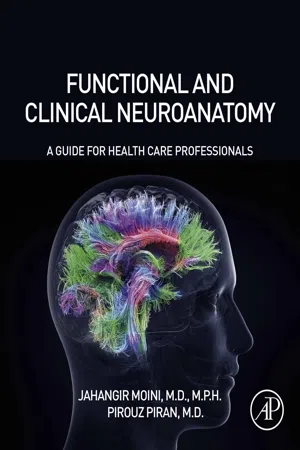
Functional and Clinical Neuroanatomy
A Guide for Health Care Professionals
- 770 pages
- English
- ePUB (mobile friendly)
- Available on iOS & Android
Functional and Clinical Neuroanatomy
A Guide for Health Care Professionals
About this book
Functional and Clinical Neuroanatomy: A Guide for Health Care Professionals is a comprehensive, yet easy-to read, introduction to neuroanatomy that covers the structures and functions of the central, peripheral and autonomic nervous systems. The book also focuses on the clinical presentation of disease processes involving specific structures. It is the first review of clinical neuroanatomy that is written specifically for nurses, physician assistants, nurse practitioners, medical students and medical assistants who work in the field of neurology. It will also be an invaluable resource for graduate and postgraduate students in neuroscience.With 22 chapters, including two that provide complete neurological examinations and diagnostic evaluations, this book is an ideal resource for health care professionals across a wide variety of disciplines.- Written specifically for "mid-level" providers in the field of neurology- Provides an up-to-date review of clinical neuroanatomy based on the latest guidelines- Provides a logical, step-by-step introduction to neuroanatomy- Offers hundreds of full-color figures to illustrate important concepts- Highlights key subjects in "Focus On" boxes- Includes Section Reviews at critical points in the text of each chapter
Frequently asked questions
- Essential is ideal for learners and professionals who enjoy exploring a wide range of subjects. Access the Essential Library with 800,000+ trusted titles and best-sellers across business, personal growth, and the humanities. Includes unlimited reading time and Standard Read Aloud voice.
- Complete: Perfect for advanced learners and researchers needing full, unrestricted access. Unlock 1.4M+ books across hundreds of subjects, including academic and specialized titles. The Complete Plan also includes advanced features like Premium Read Aloud and Research Assistant.
Please note we cannot support devices running on iOS 13 and Android 7 or earlier. Learn more about using the app.
Information
Histophysiology
Abstract
Keywords
Anatomical divisions of the nervous system

Functional divisions of the nervous system
- • The SNS regulates skeletal muscle contractions. Voluntary muscle contractions are consciously controlled. Involuntary contractions are controlled subconsciously. The automatic responses involved in involuntary contractions are called reflexes.
- • The ANS is also known as the visceral motor system. It subconsciously regulates cardiac muscle, smooth muscles, adipose tissues, and glandular secretions. The ANS includes two divisions: the parasympathetic nervous system and the sympathetic nervous system. These subdivisions usually have opposite actions. For example, sympathetic activity increases the heart rate while parasympathetic activity slows it.
Neuroglia
| Central nervous system | 1. Microglia | Small, stationary phagocytes that remove debris, wastes, and pathogens from cells. They can enlarge and move due to stimulation, and also eliminate synapses (synaptic pruning) |
|---|---|---|
| 2. Astrocytes | Have a central body with many radiating processes. They maintain the blood-brain barrier; provide structural support; control amounts of ions, nutrients, and dissolved gases; absorb and recycle neurotransmitters; form scar tissue after injuries | |
| 3. Oligodendrocytes | Have a central body with processes that wrap around their neuron processes. They myelinate CNS axons; provide framework | |
| 4. Ependymal cells | They form sheets with the motile cilia, and line ventricles of the brain and the central spinal cord canal; produce cerebrospinal fluid, and also propel it | |
| Peripheral nervous system | 1. Schwann cells | Each cell entirely wraps around the neuron processes, with an outer portion called the neurilemma. They provide myelination in the PNS; surround all PNS axons; assist in repairs following injuries |
| 2. Satellite cells | Also called satellite glial cells, they cover the surface of nerve cell bodies in sensory, sympathetic, and parasympathetic ganglia. In the neurons around ganglia, they control levels of neurotransmitters, oxygen, carbon dioxide, and nutrients; surround neuron cell bodies |
Neuroglia of the CNS
Microglia
Astrocytes
Table of contents
- Cover image
- Title page
- Table of Contents
- Copyright
- Dedication
- About the Authors
- Preface
- Acknowledgments
- Chapter 1: Histophysiology
- Chapter 2: Embryology
- Chapter 3: Gross anatomy of the brain
- Chapter 4: Meninges and ventricles
- Chapter 5: Blood supply of the CNS
- Chapter 6: Cerebral cortex
- Chapter 7: Basal nuclei
- Chapter 8: Diencephalon: Thalamus and hypothalamus
- Chapter 9: Brainstem
- Chapter 10: Cranial nerves
- Chapter 11: Trigeminal and facial nerves
- Chapter 12: Auditory system
- Chapter 13: Auditory system lesions and disorders
- Chapter 14: Visual system
- Chapter 15: Limbic, olfactory, and gustatory systems
- Chapter 16: Cerebellum
- Chapter 17: Autonomic nervous system
- Chapter 18: Neurotransmitters
- Chapter 19: Spinal cord
- Chapter 20: Spinal cord lesions and disorders
- Chapter 21: Complete neurological exam
- Chapter 22: Neurologic diagnostic procedures
- Glossary
- Index
